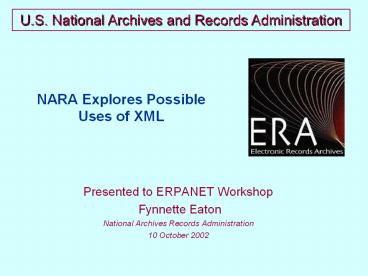NARA Explores Possible Uses of XML PowerPoint PPT Presentation
Title: NARA Explores Possible Uses of XML
1
NARA Explores Possible Uses of XML
U.S. National Archives and Records Administration
- Presented to ERPANET Workshop
- Fynnette Eaton
- National Archives Records Administration
- 10 October 2002
2
NARAs Strategic Response - ERAArchivists
Directive
NARAs Strategic Response
The Electronic Records Archives (ERA) Program is
NARAs strategic response to the problem of
electronic records. Its goal is to enable NARA
to preserve and provide access to any type of
electronic record created anywhere in the Federal
Government.
3
NARAs Strategic Response - ERAArchivists
Directive
ERA Vision Statement ERA will authentically
preserve and provide access to any kind of
electronic record, free from dependency on any
specific hardware or software, enabling NARA to
carry out its mission into the future. John W.
Carlin Archivist of the United States
4
Electronic Records Challenge NARAs Current
Electronic Records System
- 30 years of experience
- Simple Files (i.e. Structured databases, tables,
etc.) - Currently expanding preservation methods and
storage capabilities
5
Electronic Records ChallengeA Tidal Wave is
Coming
- Clinton Administration
- 40 million email messages
- State Department
- 25 million electronic diplomatic messages
- Department of Defense
- 54 million images from electronic official
military personnel files annually - Census Bureau
- 600 to 800 million image files (2000 census)
6
Recent Challenges
- Diversity
- office automation, image, video and audio formats
- Complexity
- decision support systems, GIS, applets and
interactive WWW pages - Volume, both in bytes and files
- Rapidly changing nature of systems used to create
records
7
What do we need to do?
- Overcome technological obsolescence in a manner
that preserves demonstrably authentic records - Build a dynamic solution that incorporates the
expectation of continuing change in information
technology and in the records its produces. - Find ways to take advantage of continuing
progress in information technology so as to
maintain and improve both performance and
customer service
8
Transformation Strategies
- Includes Persistent Object Preservation approach
emerging from collaborative research in which
NARA is participating. - Does not preserve records in original
technological state. - Requires precise specification of archival
requirements related to context, context,
structure and presentation of records and the
collections to which they belong.
9
Persistent Object Preservation(POP)
- Application of Distributed Object Computational
Testbed (DOCT) technologies to archival
preservation and access - Comprehensive, scalable, infrastructure
independent, flexible - Established in the core technologies of the next
generation National Information Infrastructure - Implementation of Reference Model for an Open
Archival Information System (NASA-Consultative
Committee on Space Data Systems)
10
Preservation Issues
- Uses of XML
- XML DTDs or XML Schema to manage attributes and
semantics - XML based tools to mediate between heterogeneous
collections - XTM (XML Topic Map) DTDs to manage relationships.
- Use of XSL Stylesheets to manage presentation
11
Additional Initiatives
- San Diego Supercomputer Center - Virtual Data
Grids - NARAs Electronic Records Management initiative,
one of 24 e-Government Initiatives
12
Electronic Records Initiative
- System Design Requirements for Electronic
Records Preservation and Future Use E-Mail with
Attachments - Discusses content requirements, context
requirements and structure requirements - Request records be transferred in standard markup
language, such as XML - Other formats to be considered
- Image files
13
NARAs Strategic Response - ERAERA Requirements
- Persistent
- To manage and access the records over time.
- Authentic
- To ensure that these are the original records
- Records that are created with attached
documentary information - Scalable
- To grow and adapt to increasing volumes and
evolving types of electronic records - To serve a variety of user groups
14
Keys to Success Government and Private Sector
NASA
IEE
Army ResearchLaboratory
15
ERA Timeline1998 - 2001 (Past)
- The Archivist established the ERA Program
- Research partners are formed to find solutions to
the electronics archiving challenge - Contractor Team hired to assist with program
management
16
ERA Timeline2001 - 2002 (Present)
- Continue Research Development
- Key Integrated Product Teams (IPTs) Chartered
- Key Program documents finalized
- Continued staffing of the Project Management
Office (PMO)
9/02
4/02
7/02
8/02
1QFY04
4QFY03
Requirements L1 Business Case Analysis Request
For Information RFI)
OMB300
Request for Proposal
Contract Award
Concept of Operations
Analysis of Alternatives
Requirements L0
17
ERA Timeline2003-2007 (Future)
- Official Military Personnel Files
- Test online public access
- Request for Proposal (RFP)
- Award to Performance-based Contractor
- Continue Research and Development
- Census 2006 (Mountain Information)
18
Contact Information
Electronic Records Archives Program Management
Office Fynnette Eaton (301) 837-2007
ERA Website http//www.archives.gov/electronic_r
ecords_archives/index.html

